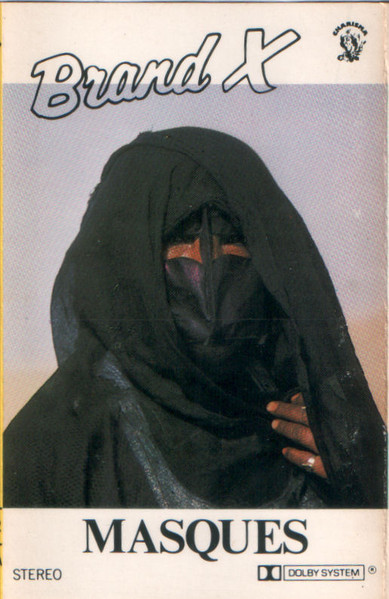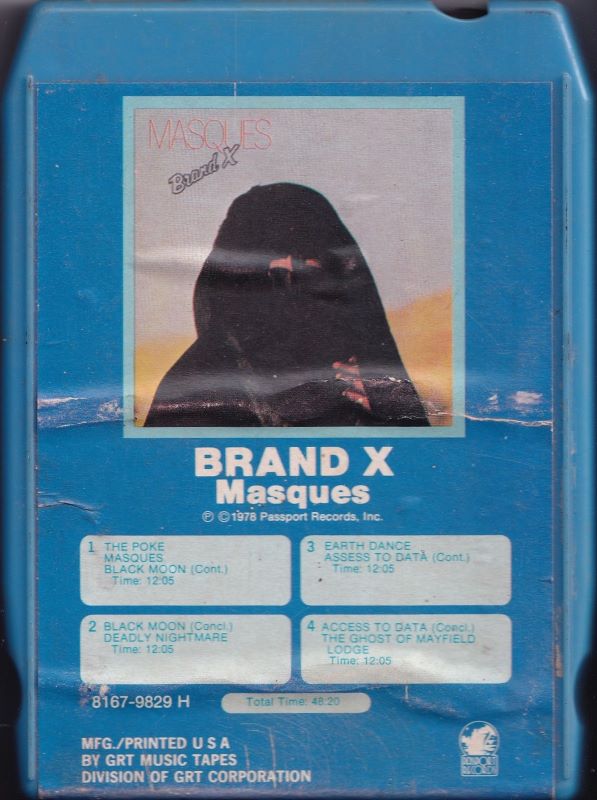
MASQUES OFF
Brand X’s Third Album Revisited
by ahand83
Looking back on my childhood and my musical discoveries I remember being inspired by Brand X’s music from a very young age. The first BX album I heard was ‘Moroccan Roll’. I got it on a cassette from Frank, a Genesis fan and collector I met through an ad on Dutch Ceefax. After that came ‘Unorthodox Behaviour’ and so on and so on. Frank once told me over the phone that he thought ‘Masques’ was BX’s weakest album. Being only 13 or so, I believed everything he said. In the end, I only bought ‘Masques’ to complete my collection, because I owned all other BX albums up to and including ‘Is There Anything About?’ I was mainly interested in what Phil Collins was doing, and therefore, I pretty much ignored ‘Masques’ until recently.
Visiting England on holiday with my parents in 1997, I attended a record fair and bought one of my first ever bootleg CDs. It was a Brand X live recording from San Francisco, 1977. I couldn’t tell from the cover if Phil Collins was on it, but I bought it anyway, with some financial help from my parents. I think it cost me three weeks of pocket money. The recording on the bootleg was released properly in 2019 by BX as part of their ‘official bootleg’ series. It’s a good live recording and there’s quite a lot of interplay between the band and the audience. It was hard to tell if Phil was on it, though… 3 out of 6 songs are from ‘Masques’, the album I hadn’t listened to until that point, because of Collins’s absence. I was a bit disappointed by the ‘Masques’ excess at first, but eventually the tracks grew on me. ‘Deadly Nightshade’ now probably is my favourite track on the album.
‘Masques’ was recorded in May/June of 1978, and the album was released in September that same year. It was recorded, like its predecessors, at Trident Studios and produced by Robin Lumley. It was BX’s third studio recording and their first album without Phil Collins. Collins was replaced by the American drummer Chuck Bürgi, who played with Al DiMeola on his Elegant Gypsy tour. There just wasn’t enough time for Collins to do both Genesis and Brand X at the same time.
Because of Collins’s absence, I guess ‘Masques’ is not really a Genesis-related album. So why bother getting into this? For one, this period can be considered an important break for Collins from Brand X. He did a highly profiled album with Genesis (‘…And Then There Were Three…’) followed by a massive world tour. Secondly, Phil’s name was connected to Brand X, because of his acquired fame with Genesis, and he was mentioned in reviews and press statements. Thirdly, the ‘new’ personnal in Brand X consisted of Peter Robinson, who would later on play keyboards for Phil on his first two solo tours. I’d say the ‘Masques’ album was made in a significant period in Genesis’ history.
‘Masques’ consists of 7 tracks, of which two of them are quite long. According to Brand X’s official website, the band was somewhat pushed into a more mainstream direction by the American Arista/Passport record company. The biography of the band tells us that Percy Jones had difficulties with getting ‘more commercial’. He expressed his objection towards the management executives but they weren’t moved by Percy’s artistic ambition. Morris Pert wrote three tracks for ‘Masques’ which is remarkable. One would consider John Goodsall or Percy Jones the main writers in the band, but on this album, the proportions were different.
The opening track ‘The Poke’ was written by Goodsall. The track’s sound is as mainstream as BX could be by that point. It’s a rock tune based on a simple rhythm with a prominent role for guitar and bass. Virtuoso licks were added, opening the album as typically as only Brand X could do. John had a very recognizable and distinctive style. He was also a very skilled composer, with strong melodies and quite sophisticated rhythms. Some of his stuff was quite challenging to play, for example “The Poke” (Percy Jones, official website). Goodsall’s heavy-riff-rock sound could later be heard on tracks like ‘Soho’ and ‘Don’t Makes Waves’, tracks that have an even more commercial approach than the stuff from ‘Masques’.
The second track is the title track. It’s an instrumental little ditty by Jones and Robinson, written for bass and piano. Morris Pert added some delightful percussion to the track. It’s a good example of what Brand X could achieve playing only three instruments and adding a bit of reverb.
‘Black Moon’ was a track from Pert and is, in my opinion, the weakest track on the album. There are some interesting chord and melody changes there, but its rather cheesy melody line and delicate production make it a disappointing piece of Brand X music.
‘Deadly Nightshade’ and ‘Earth Dance’ make up for this, both written by Morris Pert. Both tracks had a distinctive melody line repeating. ‘Deadly Nightshade’ starts off with the sound of a musical box playing a little bedtime tune. It was probably the work of Pert, tinkling away on his glockenspiel. There’s a big contrast with Goodsall’s howling guitar solo that blows through the middle section, like a tornado. ‘Nightshade’ shows how Brand X would bravely go from A to B, covering different musical styles in one single track. Chuck Bürgi provides a steady rhythm, stirring it up with fast playing and some heavy fills. Phil Collins’s absence made the drums sound different, but Bürgi’s playing was of high standards and technically challenging.
‘Earth Dance’ starts with some exciting sounds on percussion, guitar and bass. There’s a catchy melody line throughout the track, and it probably was the closest the band would ever come to making people dance! I guess the title was therefore very well chosen. Drums and percussion have a prominent role on this track. After 3 minutes, both Pert and Bürgi go loose on their instruments!
I always preferred the live version of ‘Access To Data’ on my San Francisco bootleg to the original, but the studio version grew on me. Played live, there was a more prominent role for synthesizers, and the playing seemed more aggressive. The studio production held back, and it all sounded a bit flat to me. Despite all that, there’s some great guitar playing of Goodsall, lifting the track to a climax somewhere in the middle.
‘The Ghost Of Mayfield Lodge’ was written by Percy Jones. The title refers to a haunted house where Percy once stayed the night. It’s one of the longer tracks and it lingers through different styles of music. The track starts with some great melody lines and superb bass playing by Percy Jones. Then the rhythm changes to 6/8 and heavier rock chords are set in motion, alternated by solos from Robinson and Goodsall. It’s definitely ghosts you hear, scaring the hell out of you! The middle section is a more experimental, quiet piece with interesting percussion by Morris Pert. With his accents he succeeds in creating a mysterious mood.
The album was produced by Robin Lumley. He chose not to play on the album himself because he was busy making a name for himself as a producer. The Arista Records presskit for ‘Masques’ tells us that “Lumley began to feel both that his own technical proficiency on keyboards was not quite up to the complex demands of Brand X’s music and that he needed more time to produce the band and other acts.”
The cover of the album seems to be a sequel to its predecessor ‘Moroccan Roll’ because of its ‘Arabic’ style. The person on the cover wears a burqa of some kind. The photo was shot by Chris Kutschera, a French journalist and photographer who specialised in the Middle East. Two slightly different covers were produced, for the US market and the European/Japanese market.
In 1978 Genesis headlined the Knebworth festival, and Brand X were also part of the lineup. According to multiple reliable websites Phil Collins joined Brand X on stage playing percussion on several tracks. There are no actual details on which tracks Collins contributed. It’s worth finding out. Several photos of Brand X’s performance on that day can be found on ukrockfestivals.com. Phil Collins is not in the photos. Even though Collins had some time off from his ‘hobby’ band, he was still in the picture and would return behind the drumkit in 1979.














